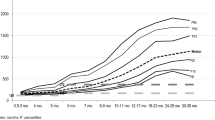Abstract
Objective
This study aimed to define the estimated average requirement and the recommended dietary allowance of iron for Indian children and adolescents.
Methods
The Estimated average requirement was derived for children aged 1–17y, from the mean bioavailability-adjusted daily physiological iron requirement, which in turn was estimated using a factorial method. This consisted of mean daily iron losses from the body and additional iron required for tissue growth and storage, while also defining the variance of each factor to derive the Recommended dietary allowance.
Results
The estimated average requirement of iron for children ranged from 5.6 to 11.0 mg/d in children aged 1–9y. For adolescents aged 10–17y, these ranged from 10.8 to 18.4 mg/d and 15.4 to 18.5 mg/d for adolescent boys and girls, respectively.
Conclusion
New estimates of estimated average requirement for iron in Indian children are presented, and same may be used to inform iron supplementation and food fortification policies.
Similar content being viewed by others
References
Indian Council of Medical Research. Nutrient requirements and Recommended Dietary Allowances for Indians. A Report of the Expert Group of the Indian Council of Medical Research, National Institute of Nutrition Hyderabad; 2010.
Ministry of Health and Family Welfare, Government of India. Anemia Mukt Bharat. Intensified National Iron Plus Initiative (I-NIPI): Operational Guidelines for Programme Manager; 2018.
Ministry of Health and Family Welfare. Food Safety and Standards Authority of India. Gazette of India: Notification; Part-2: Standards on Fortification; released on 2nd August, 2018.
Otten JJ, Hellwig JP, Meyers LD. eds. Dietary Reference Intakes: The Essential Guide to Nutrient Requirements, National Academy of Sciences. The National Academies Press Washington DC; 2006.
World Health Organization. WHO Child Growth Standards - Length/height-for-age, Weight-for-age, Weight-for-length, Weight-for-height and Body Mass Index-for-age — Methods and Development; 2006.
Hallberg L. Iron requirements, iron balance and iron deficiency in menstruating and pregnant women. In: Hallberg L, & Asp N G. editors. Iron Nutrition in Health and Disease. John Libbey & Co.; 1996. p. 165–182.
Ghosh S, Sinha S, Thomas T, Sachdeva HPS, Kurpad AV. Revisiting dietary iron requirement and deficiency in Indian women: Implications for food iron fortification and supplementation. J Nutr. 2019;149:366–71.
Kodkany BS, Bellad RM, Mahantshetti NS, Westcott JE, Krebs NF, Kemp JF, et al. Biofortification of pearl millet with iron and zinc in a randomized controlled trial increases absorption of these minerals above physiologic requirements in young children. J Nutr. 2013;143:1489–93.
Nair KM, Brahmam GN, Radhika MS, Dripta RC, Ravinder P, Balakrishna N, et al. Inclusion of guava enhances non-heme iron bioavailability but not fractional zinc absorption from a rice-based meal in adolescents. J Nutr. 2013;143:852–8.
Cook JD, Flowers CH, Skikne BS. The quantitative assessment of body iron. Blood. 2003;101:3359–63.
Nair KM, Iyengar V. Iron content, bioavailability and factors affecting iron status of Indians. Indian J Med Res. 2009;130:634–45.
Food and Nutrition Board. Dietary Reference Intakes for Vitamin A, Vitamin K, Arsenic, Boron, Chromium, Copper, Iodine, Iron, Manganese, Molybdenum, Nickel, Silicon, Vanadium, and Zinc: A report of the Panel on Micronutrients. Washington, DC: The National Academies Press; Institute of Medicine; 2001.
National Nutrition Monitoring Bureau. Diet and Nutritional Status of Rural Population. Technical report no 26, National Institute of Nutrition, ICMR, Hyderabad; 2012.
Larson L, Thomas T, Kurpad A, Martorell R, Hoddinott J, Swaminathan S, et al. Anemia in women and children in Uttar Pradesh: a path analysis of the associations between nutritional, environmental, infectious, and genetic determinants. Poster presented in Annual meeting of American Society of Nutrition, 2018. Available from: https://www.eventscribe.com/2018/posters/ASNScientific/SplitViewer.asp?PID=MjE0OTg1OTczNzY; Accessed July 19, 2018.
Bansal PG, Toteja GS, Bhatia N, Vikram NK, Siddhu A, Garg AK, et al. Deficiencies of serum ferritin and vitamin B12, but not folate, are common in adolescent girls residing in a slum in Delhi. Int J Vitam Nutr Res. 2015;85:14–22.
Funding
Funding: This work was supported by the Margdarshi Fellowship of the India Alliance to AVK, Fellowship no: IA/M/14/1/501681.
Author information
Authors and Affiliations
Corresponding author
Rights and permissions
About this article
Cite this article
Ghosh, S., Sinha, S., Shivakumar, N. et al. Daily Iron Requirements in Healthy Indian Children and Adolescents. Indian Pediatr 56, 551–555 (2019). https://doi.org/10.1007/s13312-019-1552-0
Received:
Revised:
Accepted:
Published:
Issue Date:
DOI: https://doi.org/10.1007/s13312-019-1552-0




